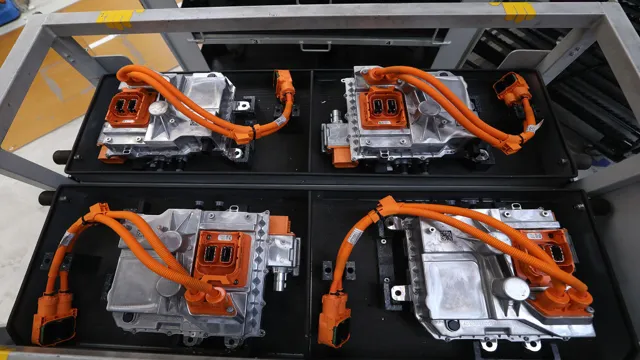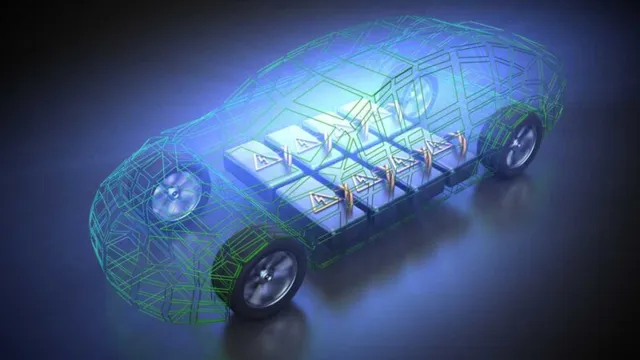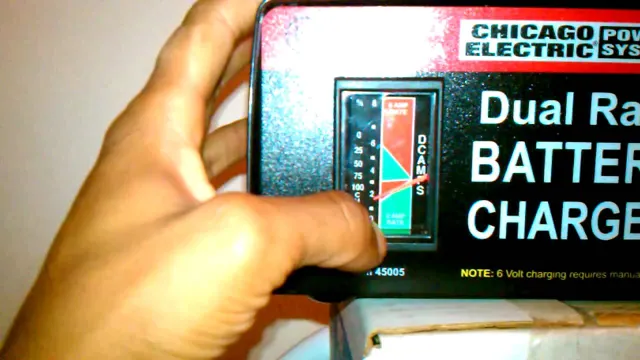Unleashing the Power: Dissecting the Key Components of an Electric Car Battery
Electric cars are becoming more and more popular as we search for alternatives to petrol-based vehicles, and their batteries are the heart of their performance. The electric car battery is a complex system and consists of many different components that work together to provide the power and range that drivers need. From the cells that make up the battery to the cooling system that keeps it from overheating, each component plays a vital role in the performance and longevity of the battery.
Understanding these components can help us understand how electric vehicle batteries work and how they can be improved. So, let’s dive in and take a closer look at the various components that make up an electric car battery.
Battery Cells
One of the crucial components of an electric car battery is the battery cell. A battery cell is made up of three key parts: the cathode, the anode, and the electrolyte. The cathode is the positive electrode that receives positively charged ions during discharge.
Meanwhile, the anode is the negative electrode that releases negatively charged ions. These two electrodes are separated by an electrolyte, which facilitates the movement of ions between them. Battery cells are the building blocks of the battery pack and typically come in varying capacities, voltages, and chemistries.
Lithium-ion is currently the most common type of battery cell used in electric cars due to its high energy density, low self-discharge rate, and long cycle life. However, research and development of alternative battery chemistries such as solid-state and sodium-ion batteries are currently ongoing, which may open up new possibilities in electric car technology in the future.
Lithium-Ion Cells vs Other Types
When it comes to battery cells, there are several different types available in the market. However, the most popular and widely used one is the lithium-ion cell. This is because lithium-ion cells are lightweight, have a high energy density, and are rechargeable.
Additionally, they have a low self-discharge rate, which means they can hold their charge even when not in use. On the other hand, other types of battery cells such as nickel-cadmium (NiCad) and lead-acid cells are much heavier and have a lower energy density. Moreover, they have a shorter lifespan and lose their ability to hold a charge over time.
Despite their limitations, these types of battery cells still have their place in specific applications such as in the automotive industry, where lead-acid batteries are still the most commonly used type. However, for most consumer electronic devices such as smartphones and laptops, lithium-ion cells remain the top choice due to their superior performance and convenience.

Cathodes, Anodes, and Electrolytes
When it comes to understanding battery cells, it’s important to grasp the terms cathodes, anodes, and electrolytes. These three components play a critical role in how batteries work. The cathode is the positive electrode in the cell and is often made of materials like lithium cobalt oxide or lithium iron phosphate.
The anode, on the other hand, is the negative electrode and is typically made of graphite or silicon. The electrolyte is the solution that serves as the medium for ion exchange between the cathode and anode. Without this solution, the battery wouldn’t be able to function.
As the battery charges and discharges, ions move back and forth between the electrodes through the electrolyte, producing the electrical energy that powers devices. Understanding the roles of cathodes, anodes, and electrolytes is essential to creating batteries that are efficient, long-lasting, and safe.
Battery Management System
Components of electric car battery play a vital role in the performance and reliability of an electric car. One of the most important components is the Battery Management System (BMS). The BMS is responsible for monitoring the state of the battery, managing its charge and discharge, and protecting it from overcharging or overheating.
It has several key components, including sensors to measure the voltage, current, and temperature of the battery, a microprocessor to process the data and control the charging and discharging, and safety devices such as fuses and circuit breakers to prevent damage to the battery or the car. The BMS also communicates with the car’s onboard computer to provide information on the battery’s status, such as its remaining charge and range. Without a properly functioning BMS, an electric car’s battery performance can suffer, leading to reduced range, shorter lifespan, and potential safety issues.
Therefore, the BMS is a critical component of an electric car battery, ensuring optimal performance and safety.
Functions and Importance
A battery management system (BMS) is an essential component of any battery-powered device, from electric vehicles to laptops. It performs several functions to ensure the efficient and safe operation of the battery, making it a crucial aspect of battery technology. The primary role of a BMS is to regulate the charging and discharging of the battery cells, maintaining their optimal state of charge and preventing overcharging or deep discharging, which can cause irreversible damage to the battery.
In addition, the BMS monitors the battery’s temperature, voltage, and current to prevent overheating and ensure the safe use of the device. It also provides information on the battery’s state of health, capacity, and remaining runtime, helping users make informed decisions about battery maintenance and replacement. Investing in a high-quality BMS ensures the longevity and reliability of the battery, making it an intelligent choice for any device that depends on battery power.
Cooling System
When it comes to the components of electric car batteries, the cooling system plays a crucial role in preventing overheating and ensuring optimal battery performance. Electric car batteries produce a significant amount of heat during operation, and if not properly managed, it can lead to accelerated battery degradation and reduced range. The cooling system consists of several components, such as a coolant pump, radiator, and a heat exchanger, which work together to regulate the temperature of the battery.
In addition, many electric vehicle manufacturers also include safety features such as thermal runaway protection, which helps prevent the battery from overheating and potentially causing a fire. Without a reliable cooling system, the overall lifespan and performance of the battery could be greatly affected, so it’s essential to have this component in top working condition.
Types and Advantages
A cooling system is an essential component of modern cars that works to regulate the engine temperature and prevent overheating. There are two main types of cooling systems: air-cooled and liquid-cooled systems. Air-cooled systems are mostly found in older cars and utilize fins and fans to blow air over the engine to dissipate heat.
On the other hand, liquid-cooled systems are more efficient and commonly used in modern cars. Liquid coolant circulates through strategically placed channels in the engine and carries the absorbed heat to the radiator, where it is dissipated into the air through the radiator grills. The advantages of liquid-cooled systems over air-cooled ones include greater efficiency, longer engine life, improved fuel efficiency and performance, and more consistent engine temperatures.
Additionally, liquid-cooled engines are more compact, quieter, and allow for a smaller hood design, resulting in better aerodynamics and improved fuel efficiency. While air-cooled systems may be simpler and cheaper to maintain, they are less efficient and may lead to uneven engine temperatures, causing some engine components to wear out faster. In conclusion, the type of cooling system used in a car can significantly impact its performance, fuel efficiency, and longevity.
While air-cooled systems may be more straightforward and less expensive, liquid-cooled systems offer superior efficiency, performance, and longevity of engine components, making them the preferred choice in modern cars. Regular maintenance and timely cooling system repairs and replacements are essential to ensure a car’s cooling system functions optimally and the engine remains in good shape.
Charging Infrastructure
When it comes to electric cars, the battery is one of the most important components. A typical electric car battery consists of individual lithium-ion cells that are connected together to form a pack. The more cells there are in the pack, the longer the range of the car.
The battery also contains a management system that controls the charging and discharging of the cells to keep them balanced and prevent damage. The charging infrastructure for electric cars is also crucial. There are a variety of charging options available, including home charging systems, public charging stations, and fast charging stations.
Ideally, an electric car owner would have access to all three types of charging options to cover all their needs. As more and more people switch to electric cars, it will be important to continue developing and expanding the charging infrastructure to make it as convenient and accessible as possible.
DC Fast Charging and Level 2 Charging
When it comes to EV charging infrastructure, there are two main types of chargers: DC fast charging and Level 2 charging. DC fast charging enables EVs to recharge quicker than traditional Level 2 charging. However, DC fast charging stations tend to be more expensive and less common than Level 2 stations.
Level 2 charging stations come in a variety of sizes and can be found in public places or installed at home. They typically take longer to recharge an EV, but offer a more affordable charging option. It’s important to consider the type of charging infrastructure that is available in your area and your driving habits to determine the best option for your EV.
With the growing demand for EVs and the need for accessible charging infrastructure, we can expect to see an increase in both DC fast charging and Level 2 charging stations in the near future.
Battery Swapping and Mobile Charging Solutions
Charging your electric vehicle (EV) efficiently and quickly is crucial to ensure a seamless driving experience. Battery swapping and mobile charging solutions have emerged as an innovative charging infrastructure in recent times. Battery swapping stations enable EV owners to replace their discharged battery with a fully charged one at a charging station, giving them the much-needed convenience to hit the roads without any delay.
On the other hand, mobile charging solutions involve a truck or van carrying a portable charging station to the customer’s location. This way, EV owners need not worry about finding a fixed charging station to juice up their ride. These mobile charging points can be conveniently set up in places like festivals, private offices, or events, where a large number of EV owners are expected to show up.
Both these solutions require a symbiotic relationship between the charging point operator, battery manufacturer, and OEMs to ensure that batteries are compatible, standardized, and of good quality. With the increasing demand for electric vehicles, battery swapping and mobile charging solutions are expected to reach greater heights in the coming years.
Future Developments
Looking ahead, the future developments in the electric car industry are focused on improving the components of electric car batteries. The current lithium-ion batteries are efficient, but the next generation of batteries is set to be even better. One promising development is the solid-state battery which could result in faster charging times, longer range, and increased safety.
Other areas of research include the use of solid-state electrolytes, silicon anodes, and AI-based battery management systems. By improving the components of the battery, electric cars can become even more reliable and efficient. This is where the industry is investing resources to drive innovation and create sustainable mobility solutions.
With these advancements, electric vehicles will become more accessible and attractive to a wider audience, leading to a significant reduction in emissions and a cleaner future for everyone.
Conclusion
In conclusion, the components of an electric car battery resemble a high-tech recipe for a power-packed dessert. The anode and cathode act as the flour and sugar, providing the basic energy source. The electrolyte acts as the egg, binding everything together and facilitating the flow of electricity.
And the separator is like the icing on the cake, keeping everything separate and preventing short circuits. Together, these components create a tantalizing concoction of energy that powers electric cars and sets them apart from their gas-guzzling counterparts. Bon appétit, EV owners!”
FAQs
What are the main components of an electric car battery?
The main components of an electric car battery are the cells, modules, and packs.
How do the cells within an electric car battery work?
The cells within an electric car battery contain a positive and negative electrode, separated by an electrolyte. When connected in a circuit, the chemical reaction between the electrodes and electrolyte creates an electrical flow.
How do the modules within an electric car battery work?
Modules consist of multiple cells connected in series and parallel arrangements to achieve the desired voltage and capacity. They are managed by a battery management system that monitors and balances the individual cells.
What is the role of the battery pack in an electric car battery?
The battery pack is the final component of an electric car battery and is responsible for housing and protecting the modules. It also allows for charging and discharging of the battery, providing power to the electric motor.






